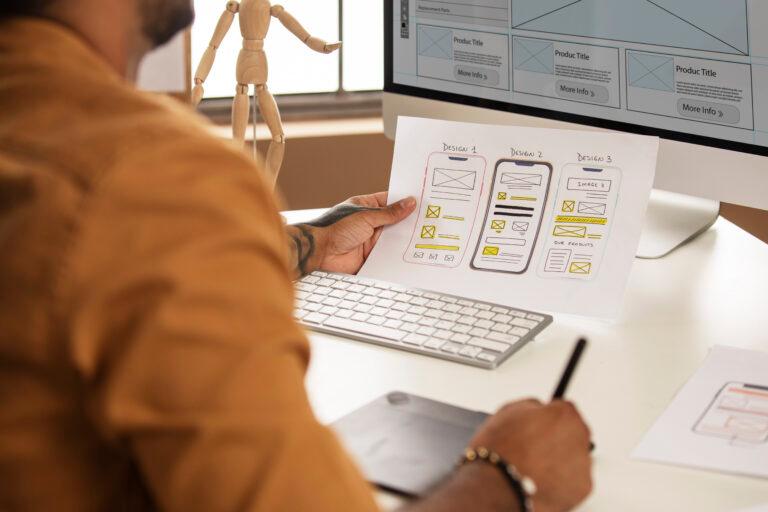Guide to Crafting a UX Portfolio for Leadership
In this article, we consider how mid-to-senior UX designers can advance their portfolios from simple assertions of individual designer skills, to demonstrating authentic leadership impact.
This article provides practical support for reframing case studies, emphasizing strategic thinking, and deliberately showcasing mentorship, enablement of teams and cross-functional influence. You will gain insights on quantifying the impact to the business, storytelling as a leader, and ultimately showcasing your work in a tone that demonstrates vision, strategy, and tangible impact. Most importantly, remarkable portfolios, regardless of formal management role, should earn recognition in online UX training, and offer opportunities for broader impact as a leader in design.
Ever felt that familiar nudge? That feeling that you’ve mastered the craft, shipped countless features, and now… you’re ready for more. You’re not alone. Many mid-to-senior UX designers reach a point where the next logical step isn’t just another project, but a leap into design leadership. But here’s the rub: the portfolio that landed you those senior IC roles won’t necessarily open the doors to management. It’s time to tell a different story.
This isn’t just about showing what you can do; it’s about demonstrating what you can lead. Let’s dive into Building your UX portfolio to reflect the strategic, influential, and impactful leader you’re becoming.
The Great Divide: IC vs. Leadership Portfolios
Think of your current portfolio as a beautifully curated art gallery – each piece showcasing your skill, your process, your pixel-perfect execution. A design leadership portfolio, however, is more like a strategic business report.

Beyond the Pixels: Crafting Your UX Portfolio for Design Leadership
Ever felt that familiar nudge? That feeling that you’ve mastered the craft, shipped countless features, and now… you’re ready for more. You’re not alone. Many mid-to-senior UX designers reach a point where the next logical step isn’t just another project, but a leap into design leadership. But here’s the rub: the portfolio that landed you those senior IC roles won’t necessarily open the doors to management. It’s time to tell a different story.
This isn’t just about showing what you can do; it’s about demonstrating what you can lead. Let’s dive into reshaping your UX portfolio to reflect the strategic, influential, and impactful leader you’re becoming.
The Great Divide: IC vs. Leadership Portfolios
Think of your current portfolio as a beautifully curated art gallery – each piece showcasing your skill, your process, your pixel-perfect execution. A design leadership portfolio, however, is more like a strategic business report.
| Feature | Individual Contributor (IC) Portfolio | Design Leadership Portfolio |
| Focus | Craft, execution, design details, problem-solving within a scope. | Strategy, influence, business impact, team enablement, vision setting. |
| Content | Screens, wireframes, user flows, detailed design solutions. | Case studies on strategic initiatives, team growth, stakeholder management, outcomes. |
| Narrative | “I designed X to solve Y.” | “I led Z initiative, enabling A team to achieve B business outcome through C strategy.” |
Your IC portfolio screams, “Look at my amazing designs!” Your leadership portfolio whispers, “Here’s how I drive change, empower teams, and deliver significant value.” It’s a fundamental shift from “how I did it” to “how I made it happen.”
The Pitfalls: Why Your Current Portfolio Might Be Falling Short
It’s easy to keep doing what’s worked before, but in the realm of management roles, these common mistakes can derail your aspirations:
- Too Many Screens, Not Enough Story: Your leadership interview isn’t a design critique. While showing some artifacts is fine, overwhelming them with UI details overshadows the strategic narrative. Hiring managers for leadership roles aren’t looking for pixel pushers; they’re looking for visionaries.
- Lack of Outcomes & Impact: “We launched X feature.” Okay, great. But what happened because you launched it? Did it increase conversion by 15%? Improve user retention? Reduce support tickets? Without quantifiable business outcomes, your work looks like busywork, not strategic impact.
- No Evidence of People or Strategy: Did you mentor junior designers? Champion a new design system? Facilitate a cross-functional workshop that unlocked a critical solution? If your portfolio only talks about your design work, it misses the leadership muscle you’ve been building.
- Ignoring the “Why”: A senior designer might explain how they arrived at a solution. A design leader explains why that particular strategic direction was chosen, connecting it to broader business objectives and market insights.
What Hiring Managers REALLY Look For in a Design Leader’s Portfolio
When hiring for design leadership, I’m not looking for the best individual designer; I’m looking for someone who can elevate the entire design function. This means I’m scrutinizing your portfolio for:
- Ownership & Vision: Did you take the initiative to define a problem space, develop a design vision, and drive it to completion? Are you someone who can see around corners and anticipate future challenges?
- Strategic Thinking & Impact: How did your work align with broader business goals? Can you articulate the strategic rationale behind your decisions and, crucially, the measurable impact on the business or product? This is where your senior UX career truly shines.
- Stakeholder Influence & Collaboration: Design leaders don’t work in a vacuum. How did you navigate complex organizational structures? Influence product, engineering, and business leaders? Your ability to communicate, negotiate, and build consensus is paramount.
- Team & Process Enablement: Have you mentored others? Contributed to design ops? Improved design processes? This shows you’re invested in growing the capability of the design team as a whole. As the Nielsen Norman Group states, “Leadership is not a title; it’s a behavior.”
Reshaping Your Portfolio: Actionable Steps
It’s time for a portfolio transformation. Here’s how to pivot from showing your design skills to showcasing your leadership prowess:
- Reframe Your Case Studies:
- Focus on the Challenge (Strategic Context): Start with the business problem, not just the user problem. What was the organizational goal?
- Highlight Your Leadership Role: Clearly articulate your specific contribution as a leader. “I led the design strategy for X…” “I mentored the team responsible for Y…”
- Emphasize Process & Influence: Describe how you facilitated alignment, managed stakeholders, championed user-centered approaches, or unblocked your team.
- Quantify the Impact: This is non-negotiable. “Reduced customer churn by 10%,” “Increased feature adoption by 25%,” “Improved team efficiency by streamlining X process.”
- Create a “Leadership Story” Section:
- Mentorship & Team Growth: Include examples of how you’ve guided junior designers, contributed to hiring, or fostered a culture of learning.
- Strategic Initiatives: Detail projects where you defined strategy, evangelized design within the organization, or implemented new processes (e.g., establishing a design system, introducing a new research method).
- Cross-Functional Collaboration: Showcase instances where you successfully partnered with engineering, product, marketing, or sales to achieve a shared goal.
- Visuals That Tell a Different Story: Instead of just screen flows, consider:
- Influence Map: A simple diagram showing key stakeholders and how you engaged them.
- Strategic Roadmap Snippet: A high-level view of how your design strategy contributed to a product roadmap.
- Here’s an example:
This diagram could show how you, as a design leader, influenced Product Management, Engineering Leads, and Business & Marketing, with arrows indicating specific actions and outcomes (e.g., “Shaped Roadmap,” “Scaled Design System”). Below, a simplified timeline showing strategic product initiatives and your role in their success. - The “About Me” Section Reinvented: This isn’t just a bio. It’s your leadership philosophy. What do you believe about building great products, empowering teams, and fostering design excellence?
The Mindset Shift: From Maker to Multiplier
Transitioning from designer to leader isn’t just about a new job title; it’s a fundamental shift in how you think and operate.
- From “I” to “We”: Your success is now intrinsically linked to your team’s success. Your job is to empower, enable, and unblock them.
- From Solutions to Strategy: You’re no longer just solving immediate design problems; you’re shaping the long-term vision and ensuring design contributes strategically.
- From Details to Direction: While you retain an eye for quality, your focus shifts from perfecting every pixel to setting clear direction and ensuring alignment.
- From Reacting to Proacting: Anticipate challenges, identify opportunities, and proactively drive initiatives that elevate the entire design function.
Your Portfolio: A Narrative of Leadership
The top of your UX portfolio for management positions is not only a collection of previous work; it’s a story of your evolution, impact, and potential as a leader. It’s your chance to tell an enticing story about how you not only create experiences but how you lead strategically to develop change. Start today. Reschedule your work through a leadership lens and leverage insights from online UX training. Look back and notice those situations where you influenced, strategized, mentored, and ultimately delivered results with impact. Your next step in a senior UX career is closer than you think – if you tell the right story.


